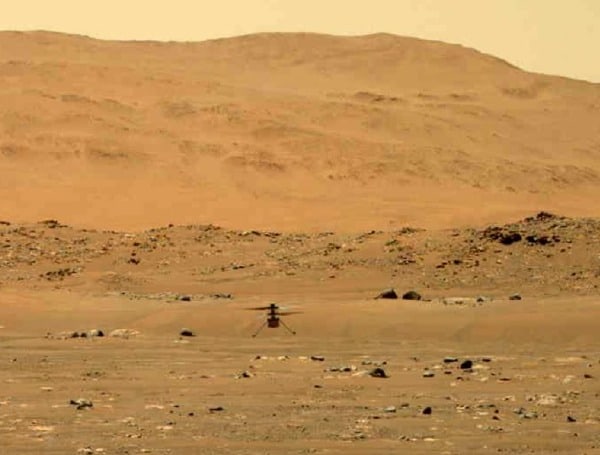NASA made history on Monday morning as their Ingenuity helicopter, designed and assembled at the Jet Propulsion Lab in Southern California, maintained a powered, controlled flight for 30 seconds.
Data, including visual evidence, was received from the Perseverance rover around 7 am EDT. This has been one of the most anticipated experiments in the Mars 2020 Project, as a controlled flight has never been achieved before off the surface of another planet.
It’s been a long journey to get here, however. After a failed high-speed rotor-spinning test on April 9th, which pushed the flight date further, and a necessary software update to modify the code that controls the rotors, it was pushing further and further into a 31-day window to do its flight tests before the Perseverance rover needed to move on to its next destination.
Since there were no other major malfunctions in the hardware, the engineers at JPL concluded that they were confident that they would be able to get Ingenuity in the air before the window closed.
The test was conducted at 3:34 am EDT, when the team determined the best solar energy and flight conditions would be. The copter flew to 10 feet and maintained its hover state for 30 seconds, and after descending, it reported a total of 39.1 seconds of flight. While this is all the information we have currently, there is expected to be additional data from the flight coming along in future downlinks from the rover.
Flight on Mars is difficult, as the planet has much lower gravity, one-third of Earth’s, and an extremely thin atmosphere which equates to only 1% of our own. On top of all that, due to the gap in commands sent and data received, the drone had to fly completely autonomously, using systems programmed by the JPL team, instead of a traditional flight controlled by a controller or joystick.
Ingenuity comes in at 4 pounds and is only 19.3 inches tall, but the intentions of its flight are gigantic. The data collected from the helicopter will be used to provide targeted information about flight characteristics for future aerial flights on the surface, be it by other autonomous vehicles or humans themselves.
When the Perseverance rover originally touched down on February 18th, there were high hopes to see what became of the little helicopter strapped to its underside. Achieving sustained and powered winged flight on Earth took the Wright Brothers to figure out, and JPL believes that this success is their ‘Wright brothers moment’, as we have finally achieved flight on another planet. The helicopter also happens to have fabric from the historic Wright Brothers flight attached to it, carrying on the legacy and wonder of flight to Mars.
Conveniently, just like the photographed documentation of the flight at Kitty Hawk, all eyes (or cameras) were on Ingenuity during this historic moment, as the Perseverance rover provided communications back to Earth regarding the flight and also recorded the flight with its cameras, the Mastcam-Z and Navcam imagers.
While we wait patiently to see what other goodies the rover has for us that will help document this amazing scientific achievement, we can’t help but wonder of the future this flight has helped create. This is only the 16th sol, or Martian day, of its flight test window, so there’s still time for more experiments to be conducted, but the next flight will be scheduled for no sooner than the 22nd of April. Multiple flights will help provide a better idea of what the ideal flight profile will be, with more data and inconsistencies to account for.
Related News: Perseverance Has LANDED! NASA’s Latest Rover is Now on Mars
